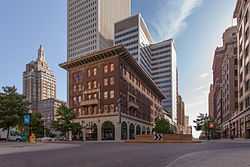Oil Capital of the World
History

The title of "Oil Capital of the World" is often used to refer to Tulsa, Oklahoma,[1][2] and more recently to Houston, Texas.[3][4]
In mid-19th century, when Pennsylvania was the first center of petroleum production, Pittsburgh[5] and Titusville[6] were considered oil capitals. In the later 19th century, before oil was discovered in Texas, Oklahoma, or the Middle East, Cleveland, Ohio had a claim to the title,[7] with 86[8] or 88[9] refineries operating in the city in 1884.
Tulsa claimed the name early in the 20th century, after oil strikes at Red Fork (1901) and Glenn Pool (1905) in Tulsa County. In 1923 a group of Tulsa oilmen organized the first International Petroleum Exposition and Congress (IPE); among the IPE's stated purposes was to "firmly establish Tulsa for all time to come as the oil center of the entire world."[10]
Tulsa continued to be known (and to promote itself) as the "oil capital of the world" into the 1950s[11] and 1960s. The IPE grew and reached its peak attendance in 1966, when the Golden Driller, a large statue symbolic of Tulsa's asserted importance in the oil industry, was erected in front of the new IPE Building, then said to be the world's largest building under one roof. By the 1970s, however, the IPE's success, and Tulsa's role in the international oil industry, had both eroded: Tulsa's last IPE was held in 1979,[12] while Houston has become the most prominent hub of the oil industry in the United States. In more recent times, Tulsa's continued use of "oil capital of the world" is often characterized as nostalgic or historical.[13][14]
National Register of Historic Places designation
In 2010, Tulsa officially designated the central part of its downtown as the "Oil Capital Historic District" for the purposes of a proposed registration in the National Register of Historic Places.[15] The district, at 36°09′04″N 95°59′24″W / 36.151°N 95.990°W, is bounded by Third Street on the north, Cincinnati Avenue on the east, Seventh Street on the south and Cheyenne Avenue on the west. It was officially listed on December 13, 2010 under Criterion A for significance in Commerce. Its NRIS number is 10001013.[16]
External links
U. S. Department of the Interior, National Register of Historic Places registration form, "Oil Capital Historic District."
References
- ↑ "Early Tulsa History / Oil and riches". Tulsa Historical Society. Retrieved April 18, 2010.
- ↑ Hirsch, James S. (2002). Riot and Remembrance: America's Worst Race Riot and Its Legacy. Houghton Mifflin Harcourt. p. 11. ISBN 0-618-10813-0. Retrieved April 18, 2010.
- ↑ "OIL: The Biggest Treasure Hunt". TIME. June 2, 1952. Retrieved April 19, 2010.
- ↑ "Oil profits help Houston boom". Marketplace radio program. Retrieved April 18, 2010.
- ↑ Leonard, Kim (October 4, 2009). "Oil boom: Pittsburgh was nation's first petroleum capital". Pittsburgh Tribune-Review. Retrieved 2011-03-19.
- ↑ "OIL: A Real Sentimental Loss". TIME. October 16, 1950. Retrieved 2011-03-19.
- ↑ Joseph G. Haubrich and Brent Meyer. "Peak Oil". Federal Reserve Bank of Cleveland. Retrieved April 19, 2010.
- ↑ Rose, William Ganson (1990). Cleveland: the making of a city. Kent State University Press. p. 428. ISBN 0-87338-428-8. Retrieved April 19, 2010.
- ↑ "The Cleveland Story / Decade by Decade / 1880s". Cleveland Museum of Art. Retrieved April 19, 2010.
- ↑ Clinton, Fred S. (Winter 1948-49). "The Beginning of the International Petroleum Exposition and Congress" (PDF). The Chronicles of Oklahoma 26: 479, 480. Retrieved 2010-04-21. Check date values in:
|date=(help) - ↑ "What Happens When LIFE Hits Tulsa?", LIFE, December 19, 1955. Excerpt available at Google Books.
- ↑ "International Petroleum Exposition" at Oklahoma Historical Society Encyclopedia of Oklahoma History and Culture (retrieved March 6, 2015).
- ↑ Barry, Dan (June 10, 2007). "THIS LAND; A Half Century of Memories That Won't Stay Buried". New York Times. Retrieved 2010-04-20.
- ↑ Everly-Douze, Susan (August 27, 1989). "What's Doing in Tulsa". New York Times. Retrieved 2010-04-20.
- ↑ Overall, Michael (November 29, 2010). "Downtown district to get new name". Tulsa World. Retrieved 2010-11-29.
- ↑ Tulsa Preservation Commission. "Oil Capital Historic District." Accessed December 25, 2011.